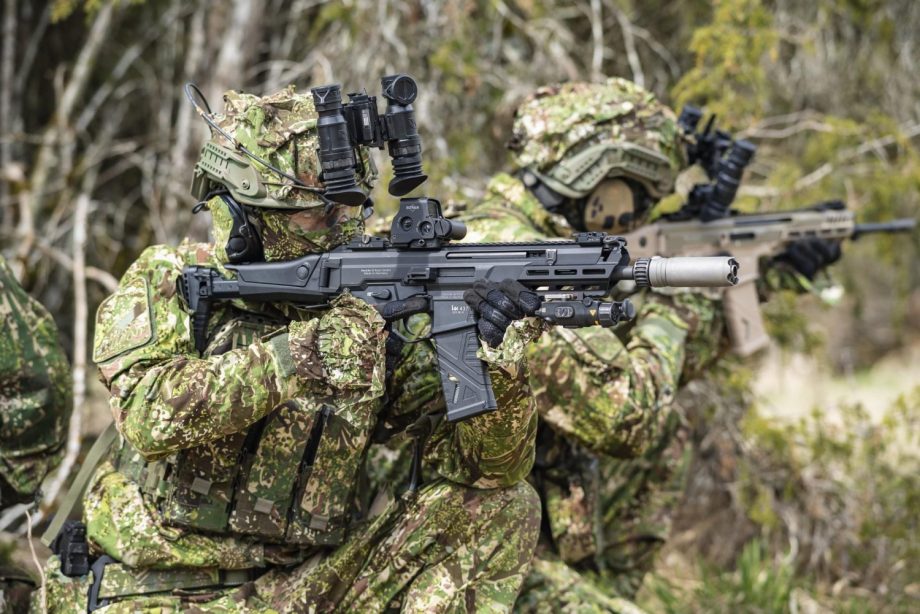By: Warren Gray
Copyright © 2022
Heckler and Koch (H&K) firearms manufacturers of Oberndorf am Neckar, Germany, has had an absolute, banner year. After initially losing a very lucrative contract in September 2020 to Haenel to supply the Bundeswehr (German Army) with a new assault rifle to replace their long-serving, H&K G36 models, H&K filed a patent-infringement appeal. By March 3, 2021, the contract was officially awarded for 20,000 examples of their new, improved, HK416A8 assault rifle with 16.5-inch barrel, to be supplied from 2022 to 2027. The company has already provided 1,705 HK416A7 (or G95K in German service) carbines with 14.5-inch barrels for the German KSK (Special Operations Command), so they have established a sterling record of success for a superb weapon that was specifically designed in 2004 for the U.S. Army’s Delta Force counterterrorist unit.
However, while the HK416 is an excellent and reliable weapon, its major drawback is still the lack of a side-folding stock, because it employs essentially the same tubular, recoil-buffer system as the Colt M4 carbine series. This single, detracting factor limits the carbine’s portability and compactness, which are vital considerations for modern, special operations units that must constantly enter and exit from helicopters or ground vehicles.
In competition for the initial, 2020, Bundeswehr contact, H&K also offered its new (since 2017), HK433 carbine in 5.56x45mm NATO, which is similar to the HK416 in operating principle. It still uses an ultra-reliable, short-stroke, gas-piston system, but is otherwise a totally-modular design, with fully-ambidextrous controls, a side-folding buttstock that shortens the weapon’s overall length by 10.5 to 11.7 inches, and six different, interchangeable barrel lengths. The cold-hammer-forged barrels are offered in sizes of 11 inches, 12.5 inches, 14.5 inches, 16.5 inches, 18.9 inches, or 20 inches, and may be easily configured in the field by the operator.
The stock can be adjusted in five positions with a three-position, cheek riser. Overall weight of the versatile HK433 averages 7.5 pounds for the 14.5-inch-barrel version, due to an extruded-aluminum, upper receiver and a polymer lower receiver. It features accessory rails and proprietary, “HKey” accessory attachment points for mounting a wide variety of optics, iron sights, flashlights, laser-aiming devices, and other attachments.
The HK433 is available in overall black finish, flat dark earth (FDE), or optional green-brown, with a trigger pull of approximately 5.3 pounds (having a very short reset), and a firing rate of 700 rounds per minute (11.7 rounds per second), down from the 850 rpm rate of the HK416 carbine in order to improve recoil management. In addition, it can accept all ordinary, AR-15-type magazines, and the weapon can be disassembled in the field without using tools.
All of this background information sets the stage for H&K’s latest development, the HK437 (the “7” stands for “special-caliber”) carbine for Special Forces units. This compact, new weapon, introduced in April 2021, uses essentially the same adjustable stock and receiver as the HK433, from which it is derived. Exceptions are that the gas block is slightly farther back, there is a modified, HK433 bolt, and the carbine is chambered for the .300 AAC Blackout (.300 BLK, or 7.62x35mm) cartridge, with barrel lengths of either nine inches or seven inches.
The .300 BLK round, introduced in 2011, was designed to have more energy and stopping power at short-to-medium ranges than combat-proven, 5.56x45mm NATO or Russian 7.62x39mm ammunition, using 125-grain, open-tip match (OTM) ammunition. It’s ideal for Special Forces use because the cartridge works very well in short-barreled carbines, and subsonic (220-grain, OTM) loads may be employed in suppressed weapons for maximum concealability, portability, and firepower.
Compared to the venerable, H&K MP5SD3 suppressed submachine gun in 9x19mm, the new HK437 has nearly double the muzzle energy, providing much longer range, better penetration against body armor, and vastly increased stopping power. Plus, with the stock folded, and the standard, nine-inch barrel, it’s actually slightly shorter than the MP5 version.
Setting it apart from the HK433, the lower receiver has been modified to prevent the accidental insertion of 5.56mm magazines into the firearm, and there is a new, synthetic, .300 BLK magazine for the same safety reasons. A variety of attachments may be mounted, and it has been seen with an EOTech EXPS holographic sight, and a Rheinmetall (German) VarioRay laser pointer. H&K currently uses Rotex V-series suppressors exclusively from B&T (formerly Brügger and Thomet) of Thun, Switzerland. (See my Gunpowder Magazine article on “Swiss Precision: The Guns of Brügger and Thomet,” from August 11, 2020.)
The U.S. Army’s Delta Force counterterrorist unit has already been using limited quantities of the SIG MCX LVAW (Low-Visibility Assault Weapon) “Black Mamba” suppressed carbine in .300 BLK in combat in the Middle East. Various SIG MCX models in .300 BLK are in use with the French mountain commandos (27th Mountain Infantry Brigade), Netherlands Maritime Special Operations Forces, Polish Grom Special Forces, and United Kingdom Special Forces. So, it’s gaining widespread acceptance and popularity with special operations forces. The Heckler and Koch HK437 is the very latest entry into this elite arena, with most of the features of the new, versatile, and innovative HK433, and the harder-hitting, suppressed, .300 BLK round for maximum, combat effectiveness.
Not much else is known about the brand-new HK437 at this point, except that its HK433 parent carbine is a superb, high-technology, modular weapon. Chambering it for the .300 BLK round enhances its close-range, combat effectiveness, especially for elite, Special Forces troops, so this is certain to be a very popular design.
* * *
Warren Gray is a retired, U.S. Air Force intelligence officer with experience in joint special operations and counterterrorism. He served in Europe and the Middle East, earned Air Force and Navy parachutist wings, four college degrees, and was a distinguished graduate of the Air Force Intelligence Operations Specialist Course, and the USAF Combat Targeting School. He is currently a published author, historian, and hunter. You may visit his web site at: warrengray54.vistaprintdigital.com.

